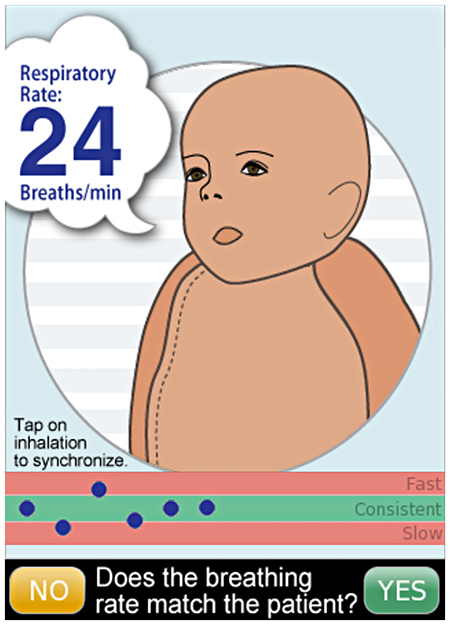A new mobile phone app developed by Faculty of Medicine researchers can measure respiratory rate in children roughly six times faster than the standard manual method.
RRate allows workers to measure respiratory rate by tapping the phone’s screen every time the child inhales. In addition to calculating the breaths per minute, the app provides an animation of a breathing baby — complete with the sound of breathing — so that a health worker can affirm that the patient’s respiratory rate matches the app’s calculation.
Currently, health care workers typically measure respiratory rate by counting a patient’s breaths for 60 seconds using a stop watch. RRate can reliably measure respiratory rate in an average of 9.9 seconds. The app’s effectiveness was described in an article published June 11 in PLOS One.
A free, non-study version of the app is available online.
“Mobile phones are changing how we administer health care, especially in rural settings and developing countries where access to medical devices is limited,” says Walter Karlen, a UBC postdoctoral fellow at the Child & Family Research Institute at BC Children’s Hospital, who co-led the study with Heng Gan, who was a CFRI clinical research fellow at the time of the study. “With this app, we can give health care workers with few resources faster and more accurate measurements, help them make better decisions, and give them more time with their patients.”
Researchers say this simple, but innovative piece of technology is a big step towards better diagnoses for children with pneumonia, the leading cause of death of children worldwide, and other respiratory illnesses. With timely and accurate diagnosis, children with pneumonia can often be saved with simple interventions such as antibiotics.
“We are leveraging the phone’s capabilities of computing, touch screen, and vibrational feedback to measure respiratory rate faster and with more confidence,” says Dr. Karlen.
Researchers collected data from 30 subjects who used the app while watching videos of children breathing at different rates. Using these findings, they developed an algorithm that enabled the app to produce accurate measurements in the least amount of time.
The next stage of this research is to further improve the diagnosis of pneumonia in low-resource settings by combining this app with the Phone Oximeter. Developed by CFRI and UBC researchers, the Phone Oximeter provides non-invasive measurements of blood oxygen levels using a light sensor and a mobile phone.
